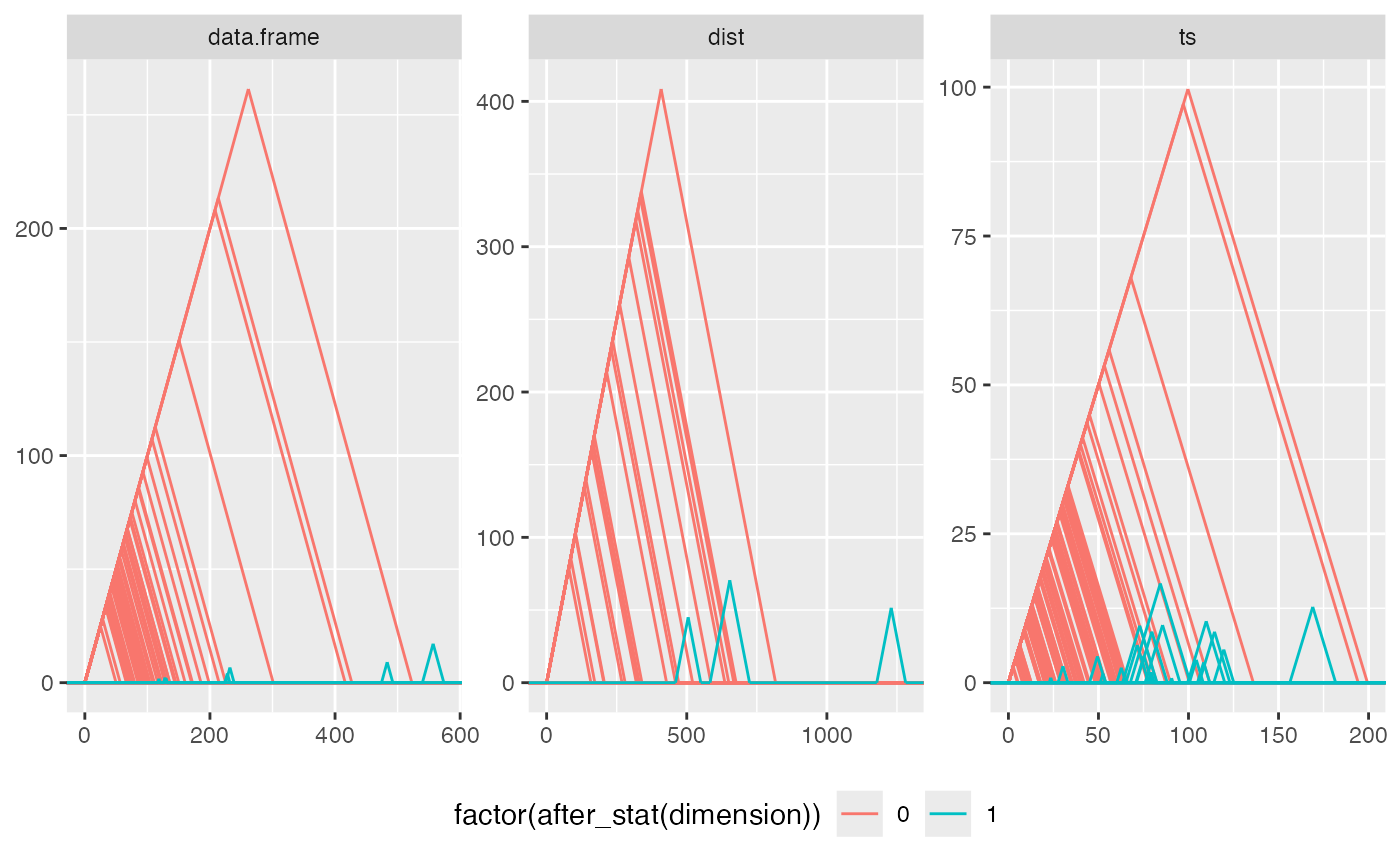Visualize persistence data as a persistence landscape.
stat_landscape(
mapping = NULL,
data = NULL,
geom = "landscape",
position = "identity",
filtration = "Rips",
diameter_max = NULL,
radius_max = NULL,
dimension_max = 1L,
field_order = 2L,
engine = NULL,
diagram = "landscape",
n_levels = Inf,
na.rm = FALSE,
show.legend = NA,
inherit.aes = TRUE,
...
)
geom_landscape(
mapping = NULL,
data = NULL,
stat = "landscape",
position = "identity",
lineend = "butt",
linejoin = "round",
linemitre = 10,
na.rm = FALSE,
show.legend = NA,
inherit.aes = TRUE,
...
)Arguments
- mapping
Set of aesthetic mappings created by
aes(). If specified andinherit.aes = TRUE(the default), it is combined with the default mapping at the top level of the plot. You must supplymappingif there is no plot mapping.- data
The data to be displayed in this layer. There are three options:
If
NULL, the default, the data is inherited from the plot data as specified in the call toggplot().A
data.frame, or other object, will override the plot data. All objects will be fortified to produce a data frame. Seefortify()for which variables will be created.A
functionwill be called with a single argument, the plot data. The return value must be adata.frame, and will be used as the layer data. Afunctioncan be created from aformula(e.g.~ head(.x, 10)).- geom
The geometric object to use to display the data, either as a
ggprotoGeomsubclass or as a string naming the geom stripped of thegeom_prefix (e.g."point"rather than"geom_point")- position
Position adjustment, either as a string naming the adjustment (e.g.
"jitter"to useposition_jitter), or the result of a call to a position adjustment function. Use the latter if you need to change the settings of the adjustment.- filtration
The type of filtration from which to compute persistent homology; one of
"Rips","Vietoris"(equivalent) or"alpha".- diameter_max, radius_max
Maximum diameter or radius for the simplicial filtration. Both default to
NULL, in which case the complete filtration is constructed.- dimension_max
Maximum dimension of the simplicial filtration.
- field_order
(Prime) order of the field over which to compute persistent homology.
- engine
The computational engine to use (see 'Details'). Reasonable defaults are chosen based on
filtration.- diagram
One of
"flat","diagonal", or"landscape"; the orientation for the diagram should take.- n_levels
The number of levels to compute and plot. If
Inf(the default), determined to be all levels.- na.rm
If
FALSE, the default, missing values are removed with a warning. IfTRUE, missing values are silently removed.- show.legend
logical. Should this layer be included in the legends?
NA, the default, includes if any aesthetics are mapped.FALSEnever includes, andTRUEalways includes. It can also be a named logical vector to finely select the aesthetics to display.- inherit.aes
If
FALSE, overrides the default aesthetics, rather than combining with them. This is most useful for helper functions that define both data and aesthetics and shouldn't inherit behaviour from the default plot specification, e.g.borders().- ...
Other arguments passed on to
layer(). These are often aesthetics, used to set an aesthetic to a fixed value, likecolour = "red"orsize = 3. They may also be parameters to the paired geom/stat.- stat
The statistical transformation to use on the data for this layer, either as a
ggprotoGeomsubclass or as a string naming the stat stripped of thestat_prefix (e.g."count"rather than"stat_count")- lineend
Line end style (round, butt, square).
- linejoin
Line join style (round, mitre, bevel).
- linemitre
Line mitre limit (number greater than 1).
Details
Persistence landscapes, anticipated by some alternative coordinatizations of persistence diagrams, were proposed as Lipschitz functions that demarcate the Pareto frontiers of persistence diagrams. They can be averaged over the diagrams obtained from multiple data sets designed or hypothesized to have been generated from the same underlying topological structure.
Persistence landscapes do not currently recognize extended persistence data.
Aesthetics
stat_landscape() understands the following aesthetics (required aesthetics are in bold):
startordatasetendordatasetgroup
geom_landscape() understands the following aesthetics (required aesthetics are in bold):
xyalphacolourgrouplinetypelinewidth
Learn more about setting these aesthetics in vignette("ggplot2-specs", package = "ggplot2").
Computed variables
stat_landscape calculates the following variables that can be accessed with delayed evaluation.
after_stat(x),after_stat(y)
coordinates of segment endpoints of each frontier.after_stat(dimension)
feature dimension (with 'dataset' aesthetic only).after_stat(group)
interaction of existing 'group', dataset ID, and 'dimension'.after_stat(level)
position of each frontier, starting from the outermost.after_stat(slope)
slope of the landscape abscissa.
Note that start and end are dropped during the statistical transformation.
References
P Bubenik (2015) Statistical Topological Data Analysis using Persistence Landscapes. Journal of Machine Learning Research, 16 77--102. http://jmlr.org/papers/v16/bubenik15a.html
F Chazal and B Michel (2017) An introduction to Topological Data Analysis: fundamental and practical aspects for data scientists. https://arxiv.org/abs/1710.04019
See also
ggplot2::layer() for additional arguments.
Other plot layers for persistence data:
barcode,
persistence
Examples
# toy example
toy.data <- data.frame(
birth = c(0, 0, 1, 3, 4, 1.5),
death = c(5, 3, 5, 4, 6, 3),
dim = factor(c(0, 0, 1, 1, 2, 2))
)
# persistence diagram with landscape overlaid
ggplot(toy.data,
aes(start = birth, end = death, colour = dim, shape = dim)) +
theme_persist() +
coord_equal() +
stat_persistence() +
stat_landscape(aes(alpha = -after_stat(level)), diagram = "diagonal") +
lims(x = c(0, 8), y = c(0, NA)) +
guides(alpha = "none")
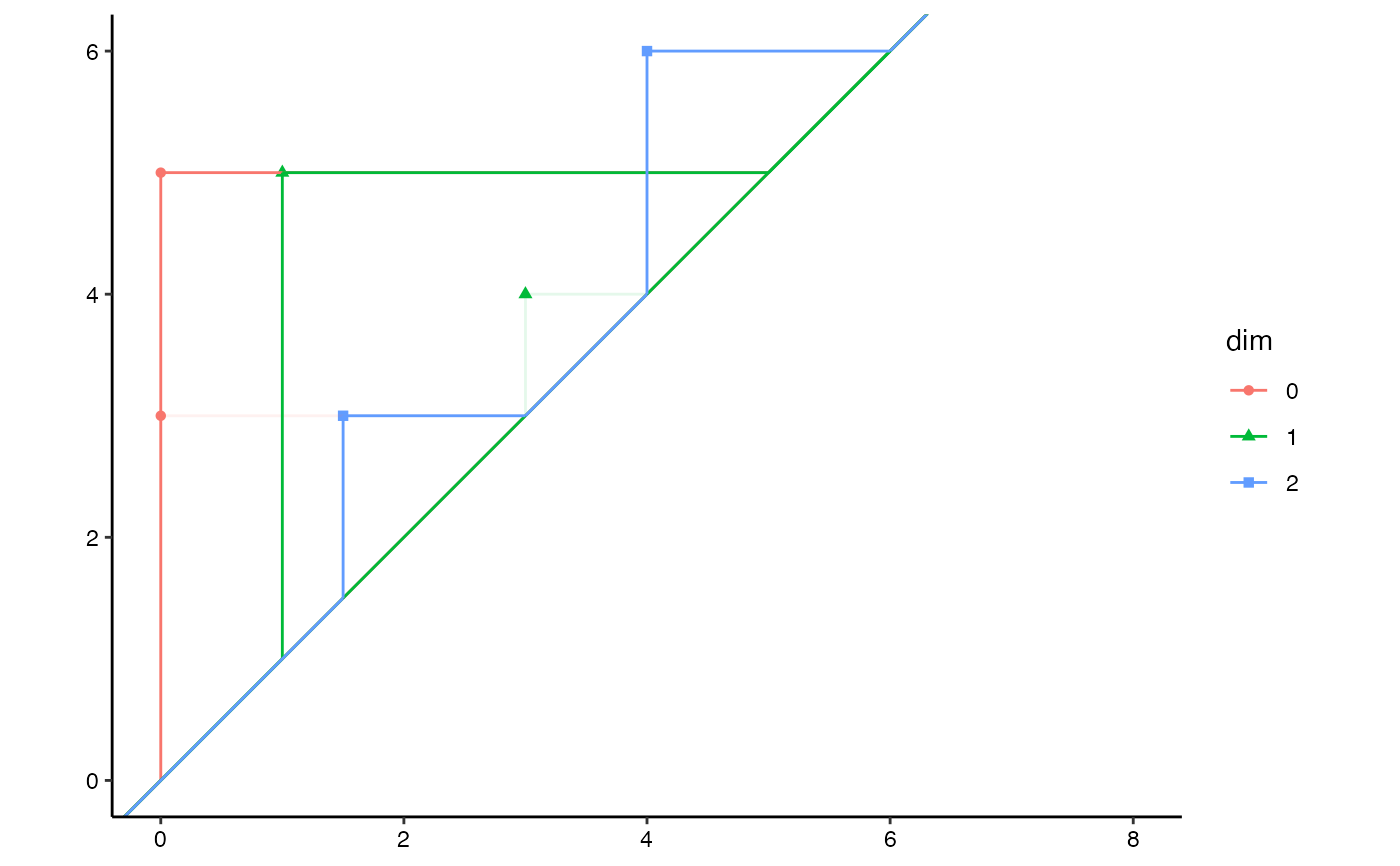 # persistence landscape with diagram overlaid
ggplot(toy.data,
aes(start = birth, end = death, colour = dim, shape = dim)) +
theme_persist() +
coord_equal() +
stat_landscape(aes(linetype = after_stat(factor(level)))) +
stat_persistence(diagram = "landscape") +
lims(x = c(0, 8), y = c(0, NA)) +
labs(linetype = "level")
# persistence landscape with diagram overlaid
ggplot(toy.data,
aes(start = birth, end = death, colour = dim, shape = dim)) +
theme_persist() +
coord_equal() +
stat_landscape(aes(linetype = after_stat(factor(level)))) +
stat_persistence(diagram = "landscape") +
lims(x = c(0, 8), y = c(0, NA)) +
labs(linetype = "level")
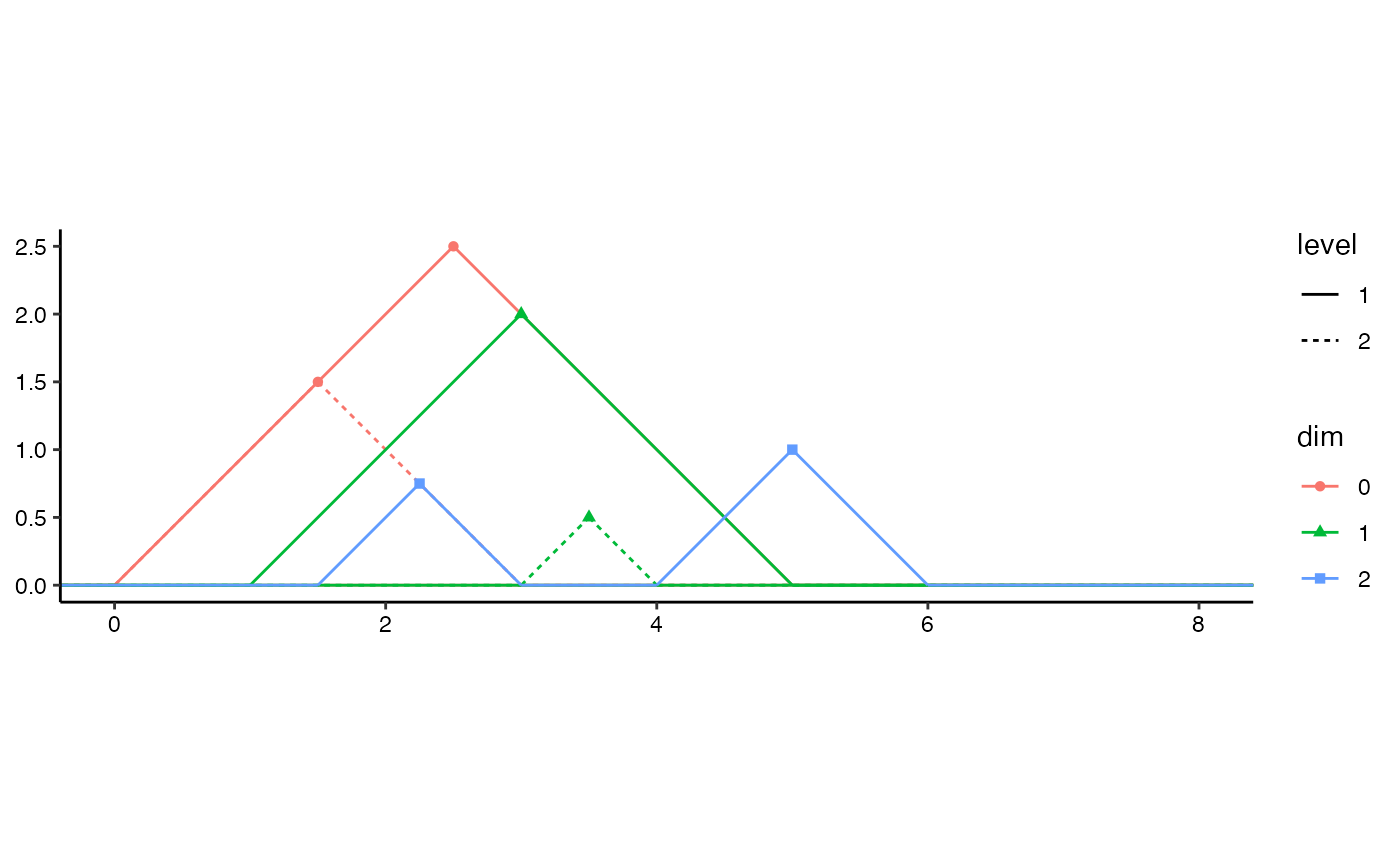 # load library and generate dataset for comprehensive example
library("ripserr")
# noisy unit circle (Betti-1 number = 1)
n <- 100L; sd <- 0.1
set.seed(7)
t <- stats::runif(n = n, min = 0, max = 2*pi)
annulus.df <- data.frame(
x = cos(t) + stats::rnorm(n = n, mean = 0, sd = sd),
y = sin(t) + stats::rnorm(n = n, mean = 0, sd = sd)
)
# calculate persistence homology and format
annulus.phom <- as.data.frame(vietoris_rips(annulus.df))
annulus.phom$dimension <- as.factor(annulus.phom$dimension)
# pretty diagonal persistence diagram
ggplot(annulus.phom, aes(start = birth, end = death,
shape = dimension, colour = dimension)) +
stat_persistence(diagram = "landscape") +
theme_persist()
# load library and generate dataset for comprehensive example
library("ripserr")
# noisy unit circle (Betti-1 number = 1)
n <- 100L; sd <- 0.1
set.seed(7)
t <- stats::runif(n = n, min = 0, max = 2*pi)
annulus.df <- data.frame(
x = cos(t) + stats::rnorm(n = n, mean = 0, sd = sd),
y = sin(t) + stats::rnorm(n = n, mean = 0, sd = sd)
)
# calculate persistence homology and format
annulus.phom <- as.data.frame(vietoris_rips(annulus.df))
annulus.phom$dimension <- as.factor(annulus.phom$dimension)
# pretty diagonal persistence diagram
ggplot(annulus.phom, aes(start = birth, end = death,
shape = dimension, colour = dimension)) +
stat_persistence(diagram = "landscape") +
theme_persist()
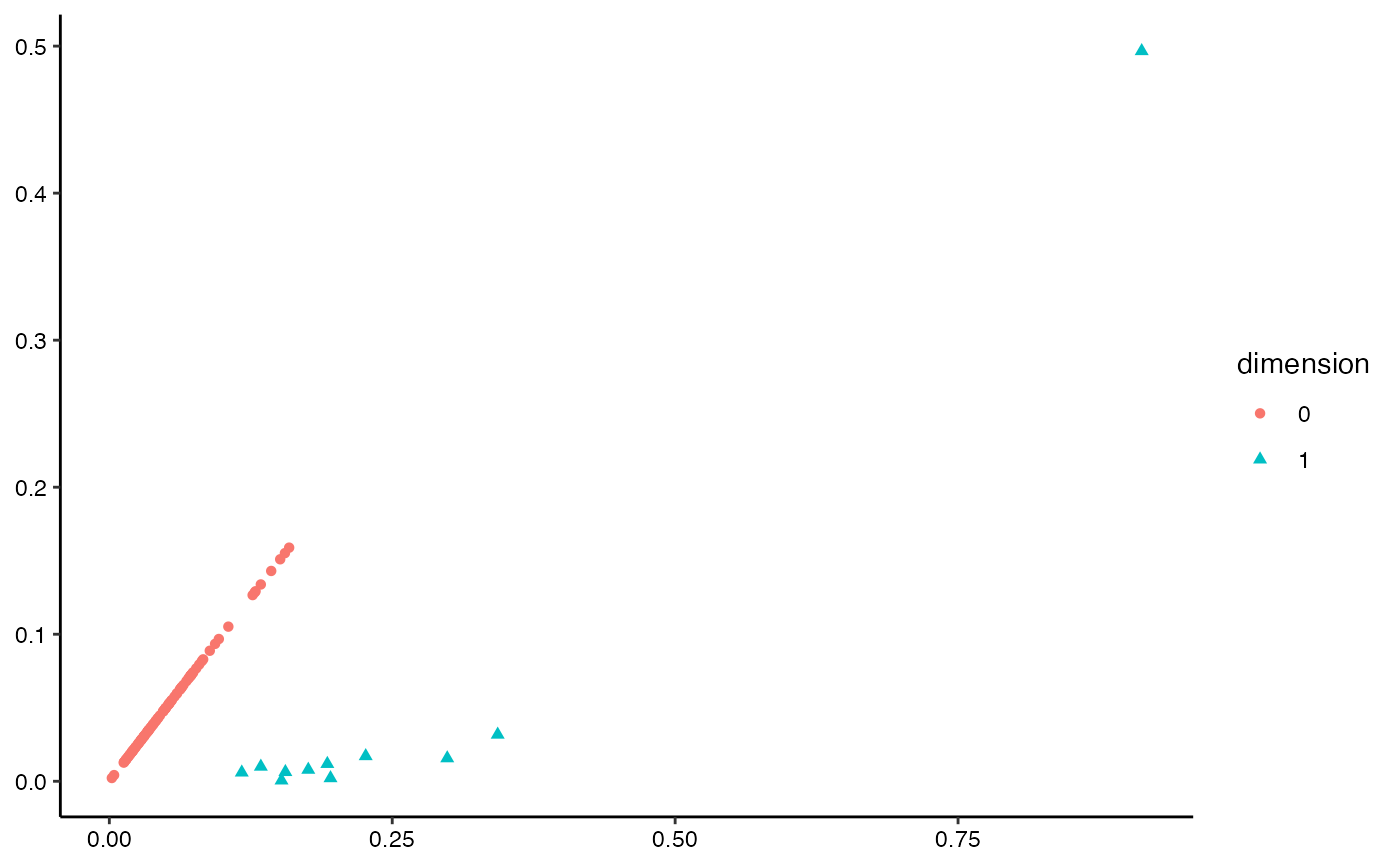 # pretty landscape persistence diagram
ggplot(annulus.phom, aes(start = birth, end = death,
shape = dimension, colour = dimension)) +
stat_landscape(diagram = "landscape") +
theme_persist()
# pretty landscape persistence diagram
ggplot(annulus.phom, aes(start = birth, end = death,
shape = dimension, colour = dimension)) +
stat_landscape(diagram = "landscape") +
theme_persist()
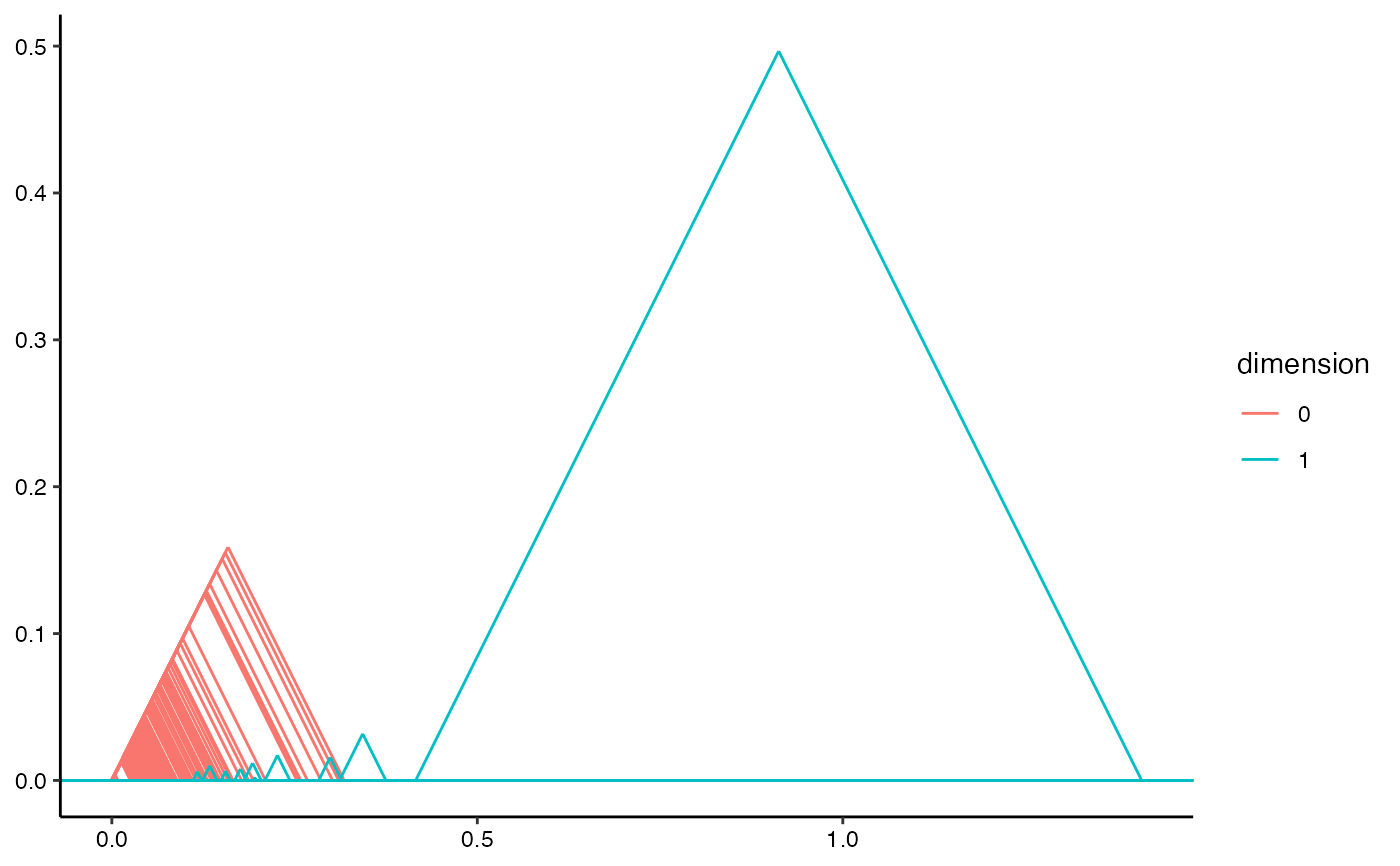 # list-column of data sets to 'dataset' aesthetic
raw_data <- data.frame(obj = I(list(eurodist, 10*swiss, Nile)))
raw_data$class <- vapply(raw_data$obj, class, "")
if ("TDA" %in% rownames(utils::installed.packages())) {
# barcodes
ggplot(raw_data, aes(dataset = obj)) +
geom_barcode(aes(color = factor(after_stat(dimension))),
engine = "TDA") +
facet_wrap(facets = vars(class))
# persistence diagram
ggplot(raw_data, aes(dataset = obj)) +
stat_persistence(aes(color = factor(after_stat(dimension)), shape = class),
engine = "GUDHI")
# persistence landscape
ggplot(raw_data, aes(dataset = obj)) +
facet_wrap(facets = vars(class), scales = "free") +
stat_landscape(aes(color = factor(after_stat(dimension))),
engine = "Dionysus") +
theme(legend.position = "bottom")
}
#> Warning: Removed 3 rows containing non-finite outside the scale range
#> (`stat_landscape()`).
# list-column of data sets to 'dataset' aesthetic
raw_data <- data.frame(obj = I(list(eurodist, 10*swiss, Nile)))
raw_data$class <- vapply(raw_data$obj, class, "")
if ("TDA" %in% rownames(utils::installed.packages())) {
# barcodes
ggplot(raw_data, aes(dataset = obj)) +
geom_barcode(aes(color = factor(after_stat(dimension))),
engine = "TDA") +
facet_wrap(facets = vars(class))
# persistence diagram
ggplot(raw_data, aes(dataset = obj)) +
stat_persistence(aes(color = factor(after_stat(dimension)), shape = class),
engine = "GUDHI")
# persistence landscape
ggplot(raw_data, aes(dataset = obj)) +
facet_wrap(facets = vars(class), scales = "free") +
stat_landscape(aes(color = factor(after_stat(dimension))),
engine = "Dionysus") +
theme(legend.position = "bottom")
}
#> Warning: Removed 3 rows containing non-finite outside the scale range
#> (`stat_landscape()`).
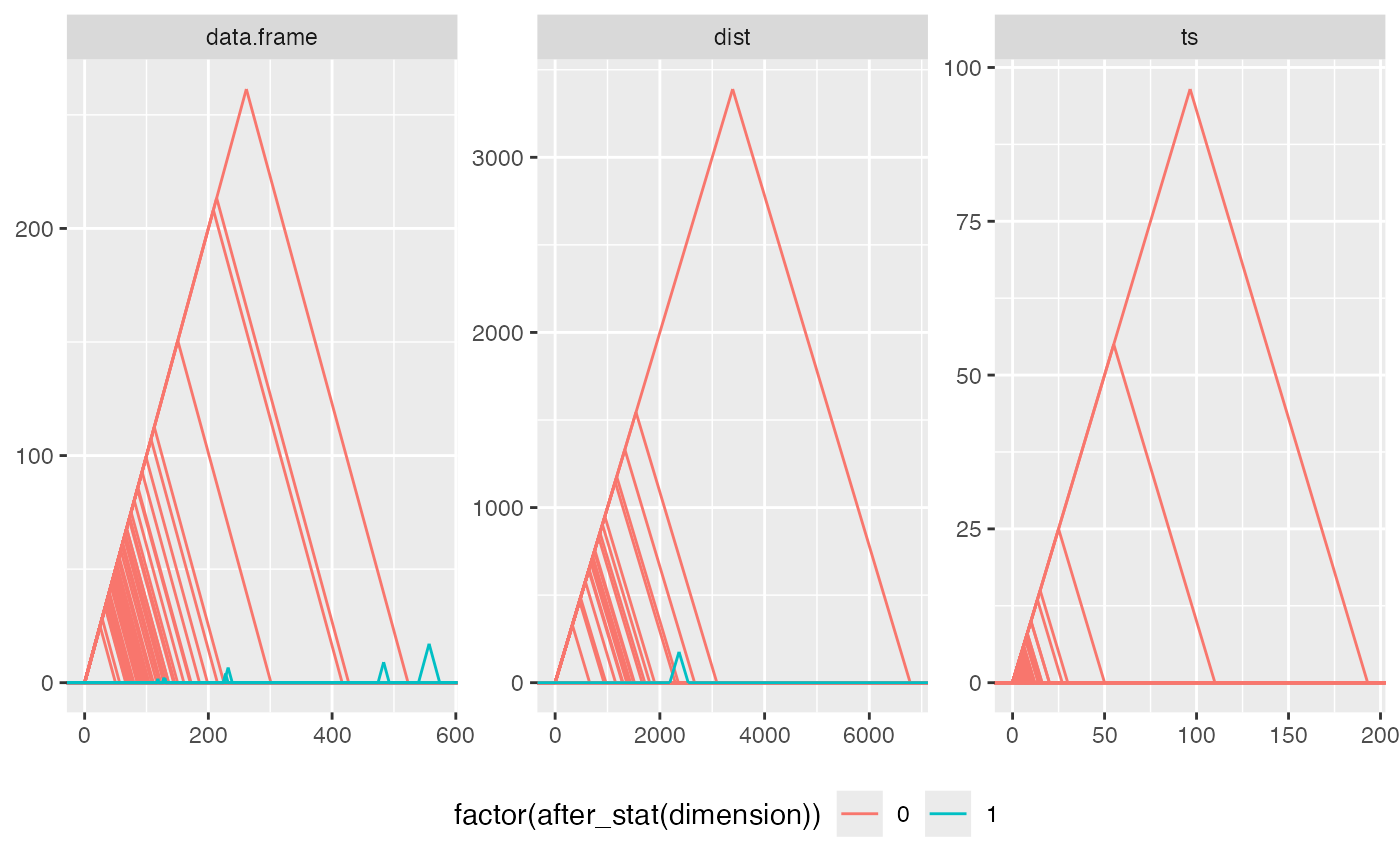 if ("ripserr" %in% rownames(utils::installed.packages())) {
# exclude time series data if {ripserr} v0.1.1 is installed
if (utils::packageVersion("ripserr") == "0.1.1")
raw_data <- raw_data[c(1L, 2L), ]
# barcodes
ggplot(raw_data, aes(dataset = obj)) +
geom_barcode(aes(color = factor(after_stat(dimension))),
engine = "ripserr") +
facet_wrap(facets = vars(class))
# persistence diagram
ggplot(raw_data, aes(dataset = obj)) +
stat_persistence(aes(color = factor(after_stat(dimension)), shape = class),
engine = "ripserr")
# persistence landscape
ggplot(raw_data, aes(dataset = obj)) +
facet_wrap(facets = vars(class), scales = "free") +
stat_landscape(aes(color = factor(after_stat(dimension))),
engine = "ripserr") +
theme(legend.position = "bottom")
}
if ("ripserr" %in% rownames(utils::installed.packages())) {
# exclude time series data if {ripserr} v0.1.1 is installed
if (utils::packageVersion("ripserr") == "0.1.1")
raw_data <- raw_data[c(1L, 2L), ]
# barcodes
ggplot(raw_data, aes(dataset = obj)) +
geom_barcode(aes(color = factor(after_stat(dimension))),
engine = "ripserr") +
facet_wrap(facets = vars(class))
# persistence diagram
ggplot(raw_data, aes(dataset = obj)) +
stat_persistence(aes(color = factor(after_stat(dimension)), shape = class),
engine = "ripserr")
# persistence landscape
ggplot(raw_data, aes(dataset = obj)) +
facet_wrap(facets = vars(class), scales = "free") +
stat_landscape(aes(color = factor(after_stat(dimension))),
engine = "ripserr") +
theme(legend.position = "bottom")
}
